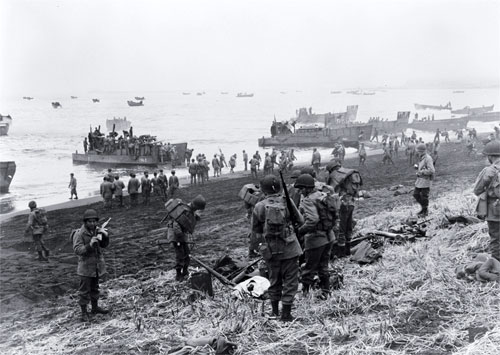
70th Anniversary of Battle of Attu Commemorated
June 24, 2013
American troops land on Attu, May 11, 1943. In this photo landing boats are shown pouring our scores of soldiers and their equipment onto the black volcanic sand of Massacre Bay.
Seventy years after young men fought and died on remote, wind-swept Attu Island in the Alaska Maritime National Wildlife Refuge, the U.S. Fish & Wildlife Service (USFWS) honored their sacrifices with the dedication of a new interpretive site on Attu. In addition to interpretive panels which tell the story of WWII in the Aleutians, a special plaque honors the deeds of Pvt. Joseph Martinez, the only Medal of Honor recipient in the Aleutian Campaign. Three interpretive panels describe the Battle of Attu, the fate of the Attu villagers and a timeline of WWII in Alaska. Redwood benches, made by veterans, allow contemplation of the now peaceful scene on the uninhabited island. Captain William Pepper (U.S. Navy veteran) of the USFWS research vessel R/V Tiglax, and an honor guard of three other veterans from the ship’s crew, conducted the dedication ceremony on June 3rd complete with taps played on a harmonica in the absence of a bugler. Captain Pepper said in his dedication remarks, “This island is hallowed ground, an important part of this nation’s history, American soil that was taken by enemy forces and then recaptured through bravery and heroism.” The Battle of Attu was the only WWII land battle in the 50 United States. This 19-day battle from May 11 – 29, 1943, ended the year long Japanese occupation of Attu. It has been described as the 2nd deadliest battle in the Pacific Theater (1st is Iwo Jima) in that the cost to retake the island was very high. For every 100 Japanese on the island, 71 Americans were wounded, killed or injured. Over 500 Americans and 2,400 Japanese died on Attu. American forces retook the island after overcoming a tenacious, dug-in foe and brutal weather for which they were poorly prepared. The war sites, part of the Alaska Maritime National Wildlife Refuge since 1913, are also now part of WWII Valor in the Pacific National Monument created in 2008 by President George W. Bush. This new monument, dedicated to telling the story of war in the Pacific, also includes refuge parcels on Alaska’s Kiska and Atka Islands and Pearl Harbor, Hawaii and Tule Lake, California. Along with the interpretive panels, the U.S. Fish & Wildlife Service’s R/V Tiglax delivered a crew of specialists to Attu to assess the remnants of war and post-war military use. WWII debris, associated contaminants, and unexploded ordnance still litter the landscape, threatening water quality, wildlife and visitors. Contaminant specialists with the USFWS and archeologists from both the USFWS and the Army Corps of Engineers surveyed portions of Attu Island. This information will be used to establish guidelines to protect sensitive historical and environmental resources during future Army Corps of Engineers clean-up efforts on Attu. The Battle of Attu Interpretive Site will ensure that future visitors will understand the magnitude and significance of the island’s war history. Captain Pepper said in his final remarks “It is our great hope that Attu Island will remain a peaceful sanctuary for wildlife, and that by learning from the past we can avoid Attu ever being a place of war again. We are honored to dedicate this site to the Attu war veterans and to the Native people who once lived on Attu.” At the time of the invasion, Aleuts from the remote and treeless islands of the Aleutians, were evacuated to temporary "camps" at locations along the Southeastern Panhandle before they could be returned to their villages. Some were housed in the old CCC barracks at Ketchikan's Ward Lake for a year. They did not fare well in the rain forest climate and conditions. Today that removal and confinement seems barbaric; it did not seem so at the time. Attu’s radio operator, Charles Foster Jones, died during the invasion and his wife Etta, the island’s schoolteacher, was taken prisoner and spent the war in a Prisioner of War camp in Totsuka, Japan. She returned to the United States in 1945. The Aleut (Unangan) residents of Attu were taken to Japan for the duration of the war. Of the 40 captives, 16 (40%) died from disease and starvation. When the surviving Attuans were released by Japan in 1945, they embarked on a long journey home via the Phillipines, San Francisco, and Seattle. When they reached Seattle, they were told that they would not be allowed to return to Attu, as the U.S. government had decided that the cost to rebuild their devastated village was prohibitive.
Edited by Mary Kauffman, SitNews
Related:
Source of News:
E-mail your news &
photos to editor@sitnews.us
|
||
